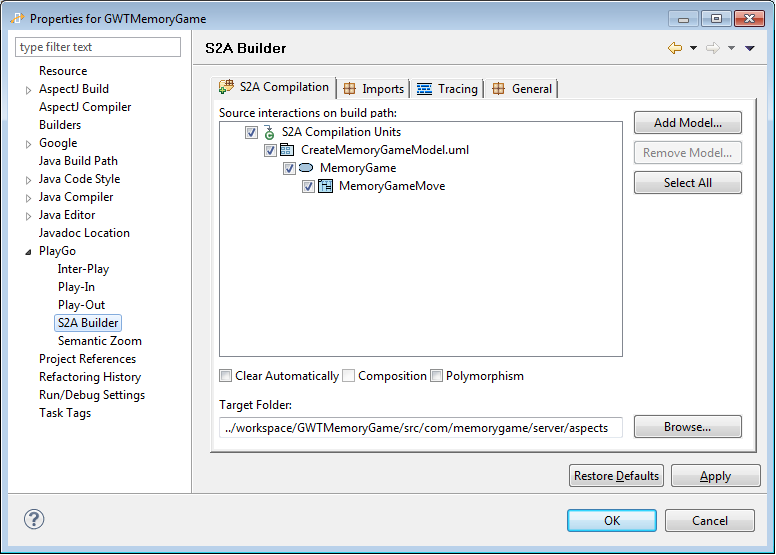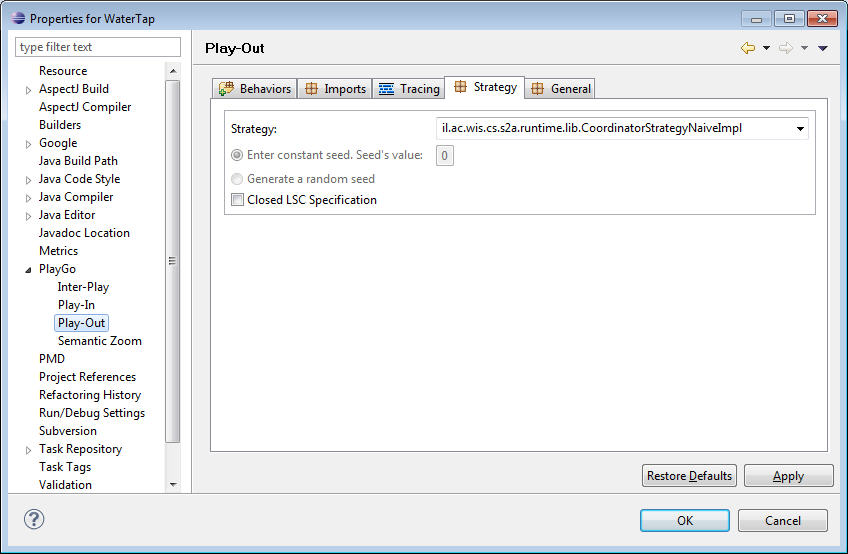Difference between revisions of "S2A Configuration"
From WeizmannWiki
(→S2A play-out properties) |
(→S2A play-out properties) |
||
| (5 intermediate revisions by one user not shown) | |||
| Line 1: | Line 1: | ||
| − | Basically the examples provided are configured with relative paths and should work well in your environment | + | Basically, the examples provided are configured with relative paths and should work well in your environment. However this is a good opportunity to introduce some parts of the configuration that you can control. |
| − | ==S2A | + | ==S2A builder properties== |
| − | Right click the | + | Right-click the project you work on and choose Properties->PlayGo->S2A Builder: |
| − | [[Image:S2a.properties. | + | [[Image:S2a.properties.png]] |
| − | As shown in the screenshot above, there are | + | <br> |
| + | As shown in the screenshot above, there are four tabs, in which you can configure properties related to S2A Builder: | ||
| − | + | #S2A Compilation | |
| + | ##Source interactions on build path: Add and remove model files that you want to compile with S2A. For the models you add, you may choose which LSCs should be compiled by S2A. In other words, which LSCs will participate in the system execution. | ||
| + | ##Target Folder: Here you specify the directory in which the generated aspects will be located. | ||
| + | ##Clear Automatically: If on, cleans the aspects directory before generating new aspects. | ||
| + | ##Polymorphism: Enable or disable polymorphism. | ||
| − | + | #Imports | |
| − | + | ##Add and remove Java packages that will be imported in the generated aspects. | |
| − | + | ##Specify the output package name: The package of the generated aspects. | |
| − | + | #Tracing | |
| − | + | ##Generate trace: Check if you want to generate a trace/log at runtime. | |
| − | + | ##Append: Check if you want to append the log to the existing log (rather then deleting and adding new content). | |
| − | + | ##Output file: The path and name of the generated trace file. By default, the trace file is generated in the root directory of your project. | |
| − | + | ##LSCs to trace: Check those LSCs you would like to trace. Check or uncheck the model root to apply your selection on all LSCs. | |
| − | + | #General: Currently used only for specifying the log4j configuration location. | |
| − | + | ||
| − | + | ||
| − | + | ||
| − | + | ||
| − | + | ||
<big></big> | <big></big> | ||
| Line 29: | Line 29: | ||
==S2A play-out properties== | ==S2A play-out properties== | ||
| − | Right click | + | Right click your project and choose Properties->PlayGo->Play-Out |
[[Image:S2a.playout.properties.jpeg]] | [[Image:S2a.playout.properties.jpeg]] | ||
| − | <br>Here you can choose | + | <br>Here you can choose a play-out strategy from a set of [[PlayGo_Feature_List#Na.C3.AFve_play-out | predefined strategies]]. |
| − | # | + | |
| − | + | ||
Latest revision as of 12:51, 18 December 2011
Basically, the examples provided are configured with relative paths and should work well in your environment. However this is a good opportunity to introduce some parts of the configuration that you can control.
S2A builder properties
Right-click the project you work on and choose Properties->PlayGo->S2A Builder:
As shown in the screenshot above, there are four tabs, in which you can configure properties related to S2A Builder:
- S2A Compilation
- Source interactions on build path: Add and remove model files that you want to compile with S2A. For the models you add, you may choose which LSCs should be compiled by S2A. In other words, which LSCs will participate in the system execution.
- Target Folder: Here you specify the directory in which the generated aspects will be located.
- Clear Automatically: If on, cleans the aspects directory before generating new aspects.
- Polymorphism: Enable or disable polymorphism.
- Imports
- Add and remove Java packages that will be imported in the generated aspects.
- Specify the output package name: The package of the generated aspects.
- Tracing
- Generate trace: Check if you want to generate a trace/log at runtime.
- Append: Check if you want to append the log to the existing log (rather then deleting and adding new content).
- Output file: The path and name of the generated trace file. By default, the trace file is generated in the root directory of your project.
- LSCs to trace: Check those LSCs you would like to trace. Check or uncheck the model root to apply your selection on all LSCs.
- General: Currently used only for specifying the log4j configuration location.
S2A play-out properties
Right click your project and choose Properties->PlayGo->Play-Out
Here you can choose a play-out strategy from a set of predefined strategies.

